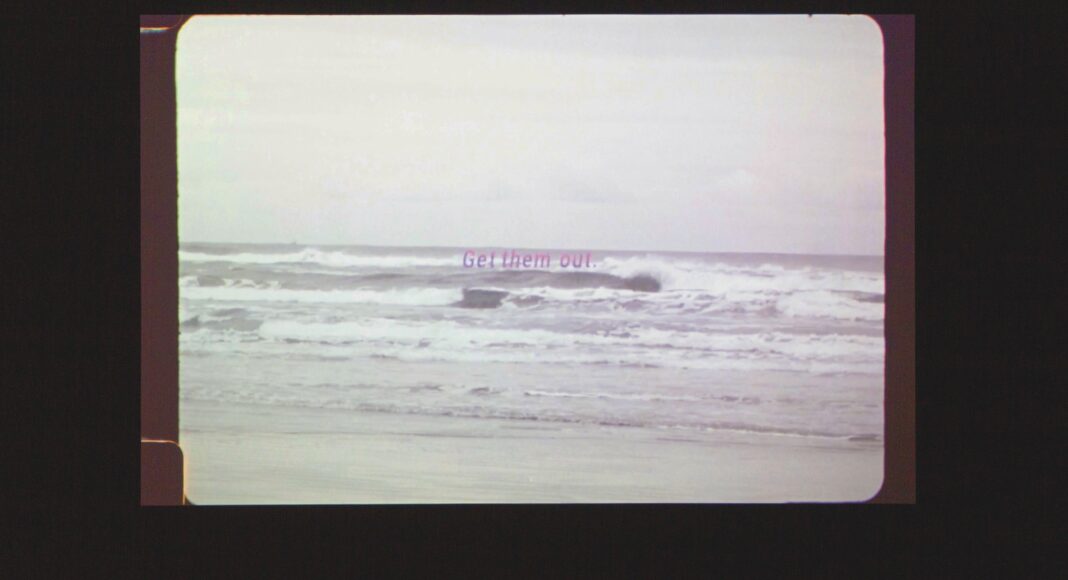Pacific redwoods stretch through a dense gray fog seemingly without end. Seascapes form from waves of gray. Mournful tones sound as words appear over the crushing sea: “Get them out.”
In this disconsolate meditation on incarceration, it seems the land and sea themselves cry out against confinement.
Multimedia and film artist Sky Hopinka’s visually striking new exhibit Seeing and Seen opened on Nov. 4 at the San Jose Museum of Art. The exhibit features a new short film commissioned by the museum on the topic of prison abolition.
A Native American artist descended from the Ho-Chunk Nation of Wisconsin and the Pechanga Luiseño Band of Riverside County, Hopinka first started creating film work at 27. At the time, he felt he wasn’t seeing contemporary Indigenous experience represented on screen.
“In mainstream American culture, if you’re not wearing a headdress and riding a horse then you’re not a real Indian,” Hopinka says.
His new film, Sunflower Siege Engine, blurs the lines between documentary and experiment. The forests and gray ocean landscapes create dreamlike sequences. In colder, static shots, a documentary plays on a laptop in a hotel room, showing the Indigenous occupation of Alcatraz Island between 1969 and 1971.
In segments of the documentary, protester Richard Oakes, a Mohawk Native and activist, reads out the Alcatraz Proclamation, which declares Alcatraz should be returned to Indigenous peoples. Listing the reasons Alcatraz would be a suitable reservation, Oakes illuminates the harsh similarities between the rocky, derelict prison island and reservations.
“One, it is isolated from modern facilities and without adequate means of transportation. Two, it has no fresh running water. Three, it has inadequate sanitation facilities.”
Hopinka is a recent MacArthur fellow and award-winning filmmaker. His extensive body of work includes photographs, digital and analog film and text art. His text art takes historical statements, poems, dialogue, and transforms them by shaping them, either into repeating scrolling patterns or single images like wild birds.
One such piece is a quote from Elliot Weinberger in the shape of a bird in flight. It encapsulates much of the motivation behind Hopinka’s art.
It reads: “There are vast areas of human life to which scientific methodology is inapt; to which ethnographic description must give way to the ethnopoetic: a series of concrete and luminous images arranged by intuition rather than prescription, and whose shifting configurations like points of and between the constellations map out a piece of the world.”
The text’s lengthy sentence requires attention, a concept the artist uses to draw audience members in, making them participants.
“I was really interested in that idea of attention, and where your eye goes and what you can look at or what you can’t look at and see,” Hopinka says.
Seeing and Seen is part of a multi-site exhibition. At UC Santa Cruz, Hopinka’s film Cloudless Blue Egress of Summer demands attention by playing two conjoined sets of sound and image. Often displayed on two adjacent walls, the film explores the legacy of Fort Marion, built in St. Augustine, Fla., in 1672. Long used as a prison for Indigenous people, the fort is where Captain Richard Pratt first hatched the idea to “kill the Indian, and save the man,” a plan of forcing Indigenous children into boarding schools where they would be forcibly assimilated into Christian religion and white customs.
Rachel Nelson, director of the exhibit at UCSC, says she hopes the work will raise awareness of creative alternatives to incarceration.
“Hopinka’s work provides important critiques of US carceral history, and we hope the exhibition will create a platform for a broader discussion about the incarceration of Indigenous people in the United States,” she says.
SJMA senior curator Lauren Schell Dickens adds that Hopinka’s visualization of abolition makes the concept, which is usually dealt with in figures and statistics, both human and emotional.
“We all know the numbers around incarceration, we all know the statistics,” Dickens says, “but, as Angela Davis said, ‘artists are key in teaching us to feel what we already know.’ That’s what Sky is doing.”
Sky Hopinka
Showing through July 19
San Jose Museum of Art, San Jose



